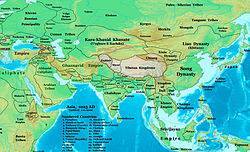Khitan / Liao 契丹 / 遼 / 𐰶𐰃𐱃𐰪 | |||||||||||||
|---|---|---|---|---|---|---|---|---|---|---|---|---|---|
| 388–1211 | |||||||||||||
 Location of Khitan-Liao (1025) | |||||||||||||
| Capital | Shangjing (918–1120) | ||||||||||||
| Common languages | Khitan language | ||||||||||||
| Government | Monarchy | ||||||||||||
| King, Chief, Emperor | |||||||||||||
| History | |||||||||||||
• split from Kumo Xi | 388 | ||||||||||||
• set up the Liao dynasty | 907 | ||||||||||||
• defeated, some absorbed, some exiled | 1125 | ||||||||||||
• final defeat in a coup | 1211 | ||||||||||||
| Population | |||||||||||||
• peak | 9,000,000 | ||||||||||||
| |||||||||||||
| |||||||||||||
The history of the Khitans dates back to the 4th century. The Khitan people dominated much of northern China, Manchuria and the Mongolian Plateau. They subsequently established the Liao dynasty and the Western Liao dynasty.
Originally from Xianbei origins, the Khitans were part of the Kumo Xi tribe until 388 when the Kumo Xi–Khitan tribal grouping was defeated by the newly established Northern Wei dynasty. This allowed the Khitans to reorganize and consolidate their own tribal identity which led to the beginning of Khitan written history.[1]
From the 5th to the 8th centuries, the Khitans were dominated by the Turks and then the Uyghurs in the west, various Central Plain dynasties in the south, and Goguryeo in the east. Despite coming under the domination of other polities, the Khitans grew in power. Their rise was slow compared to others because they were frequently crushed by neighbouring powers—each employing the Khitan warriors when needed but ready to crush them when the Khitans became too powerful.[2]
Following the collapse of the Tang dynasty in the early 10th century, they founded the Liao dynasty in 916. The Liao dynasty proved to be a significant power north of the Central Plain and it gradually expanded to occupy other territories including the Sixteen Prefectures. They eventually fell to the Jin dynasty in 1125, who subordinated and absorbed the Khitans to their military benefit.[2]
Following the fall of the Liao dynasty, many Khitans migrated westward and established the Western Liao dynasty. Although the Khitans no longer survive as a distinct ethnic group in contemporary times, their name is preserved in the Russian word for China (Китай, Kitay) as well as the archaic English (Cathay) Portuguese (Catai) Hungarian (Kína) and the Spanish (Catay) appellations of the name.
